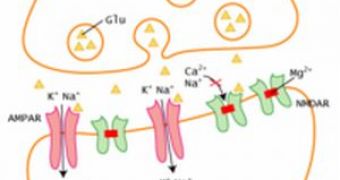Researchers at University of Pittsburgh have found how NMDA (N-methyl-d-aspartate) receptors, brain proteins, allow your neurons to communicate with each other and store memories. Molecular receptors transmit charged particles (ions) between the outside and inside of cells realizing neuronal communication. The team studied how the effects of ions vary between different types of receptor molecules.
They did it through computer modeling to show that these variations led to the specialization of receptor function. "This research helps explain how evolution accomplished a critical goal: producing receptor proteins with finely tuned properties that help optimize brain function," said Jon W. Johnson, associate professor of neuroscience.
Amongst NMDA types, NR1/2D receptors were the least-studied but they have proved to play important roles in the brain, being involved in long-term depression (which, together with like long-term excitation, is essential for learning and memory) and disease. "A better understanding of how NMDA receptors work could lead to better treatments for schizophrenia, Alzheimer's disease, and stroke," said Johnson.
Strengthening synapses (connections between neurons, in this case brain neurons) leads to memory storage. When you touch a hot object, the pain signal from your hand's skin and the view from your retina reach brain zones at about the same time, forming a memory.
In fact, this is it: memory requires the simultaneous and coordinated activation of receptors at synapses. The flow of Calcium ions through a channel in NMDA receptors is crucial.
Neurons transmit an information (an electrical impulse) to another by releasing glutamate at a synapse that binds to NMDA receptors on the synapse surface of the receiving neuron. If the receiving neuron is strongly excited, magnesium ions are ejected from the channel of NR1/2A receptors, one NMDA receptor subtype. Calcium ions then replace magnesium ions through the open channel into the receiving neuron at the synapse, strengthening the synapse and you've got a memory: "hot stove = pain."
Another NMDA type that seems to be important in memory processes is NR1/2D. Contrary to NR1/2A receptors that need strong excitation to accept calcium ions flow across the membrane, NR1/2D receptors are excitable even to weak signals. The magnesium ion, which keep position strongly in the channels of NR1/2A receptors, gets out much more easily in NR1/2D receptors. These receptors allow magnesium ions more mobility; they can flow through the channel without getting stuck in the middle.
The team used also the technique of patch clamp recording: the charge that flows through one open channel in tiny pieces of cell membrane was measured. This allowed them to see exactly when the magnesium ion entered and got out from the ion channel. "Because of our currently limited understanding of NR1/2D receptors, drawing a direct link to human disease and memory is speculative, but I am confident that the links will become firmer as research progresses," Johnson said.

 14 DAY TRIAL //
14 DAY TRIAL //